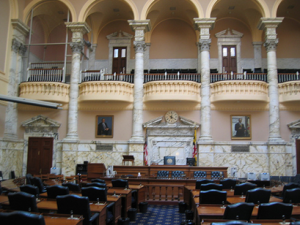House Appropriations Committee Restores Funding Where it is Needed the Most
House lawmakers’ decision to restore around $250 million in cuts proposed by Gov. Hogan recognizes that tho se who can least afford it do not deserve to have the state’s budget balanced on their backs — namely, children and poor pregnant women.
se who can least afford it do not deserve to have the state’s budget balanced on their backs — namely, children and poor pregnant women.
The House Appropriations Committee budget restores funding for education, health services, and public employees, while still cutting the state’s long-term deficit by 74 percent. If all changes are accepted by the Senate, the remaining deficit would be a tiny fraction — four tenths of one percent — of the overall budget. This deficit could then be eliminated relatively easily in the 2016 legislative session.
The restoration of education funding came mainly from the committee’s decision to provide the full amount of additional funding to schools in areas of the state where the costs of educating children are higher. The governor’s cuts to the Geographical Cost of Education Index (GCEI) would have disproportionately harmed schools in the state’s urban areas — Baltimore City and Prince George’s County. Together, they would have lost over $60 million in education funding from the state in fiscal year (FY) 2016, which starts July 1.
However, the governor has the final say on this issue. He didn’t include the GCEI spending in his budget and the legislature can’t add money.
In total, the committee voted to restore $130 of the $143 million in education aid cuts that Governor Hogan made. It also rejected proposed changes to the formulas used to determine funding levels for community colleges, private colleges, and annual increases for K-12 education, so by law they will receive additional money in the budget. In addition, the committee rejected a proposal to cap state spending formulas in future years. The cap would have made policymakers less accountable to the public and severely limited the state’s ability to respond to changing economic conditions.
The committee restored some cuts in health and mental health programs. Members of both political parties had expressed concerns about the governor’s proposed funding cuts for Medicaid doctors, mental health workers and free medical care to low-income pregnant women.
The committee kept in place the promised 2 percent cost-of-living increase for state employees, which will not require the governor’s approval. The raise took effect Jan. 1, but the governor proposed rolling it back after July 1.
To restore the funding to all of those areas, the committee cut other parts of the governor’s budget. The largest was limiting payments to the state employees’ pension fund by $75 million.
The committee’s changes represent about a 1.5 percent increase in the $16.2 billion budget proposed by Governor Hogan for the general fund, which is made up of state resources, and a 0.6 percent increase of the overall budget, which also includes federal funds. The governor would have to agree to some of the changes in order for them to take effect. This is because the committee’s budget is larger than the governor’s $40.7 Billion budget.
Despite many positive changes, the committee left intact a 2 percent across-the-board cut in agency spending. So far, the Hogan administration has left the public and lawmakers in the dark about exactly how it plans to make these reductions. In fact, Budget Secretary David Brinkley aid during a hearing that the administration does not intend to ever provide details on what those cuts will be.
While the House Appropriations Committee’s actions were laudable, lawmakers should also consider passing a trio of bills – known as the Fair Tax Package – that would level the playing field for local businesses and give a tax break to 92 percent of Marylanders, particularly those making less than $50,000. The legislation would also ask the wealthiest Marylanders to pay a bit more tax so that the state could continue to invest in schools, health care and other building blocks of our modern economy.
